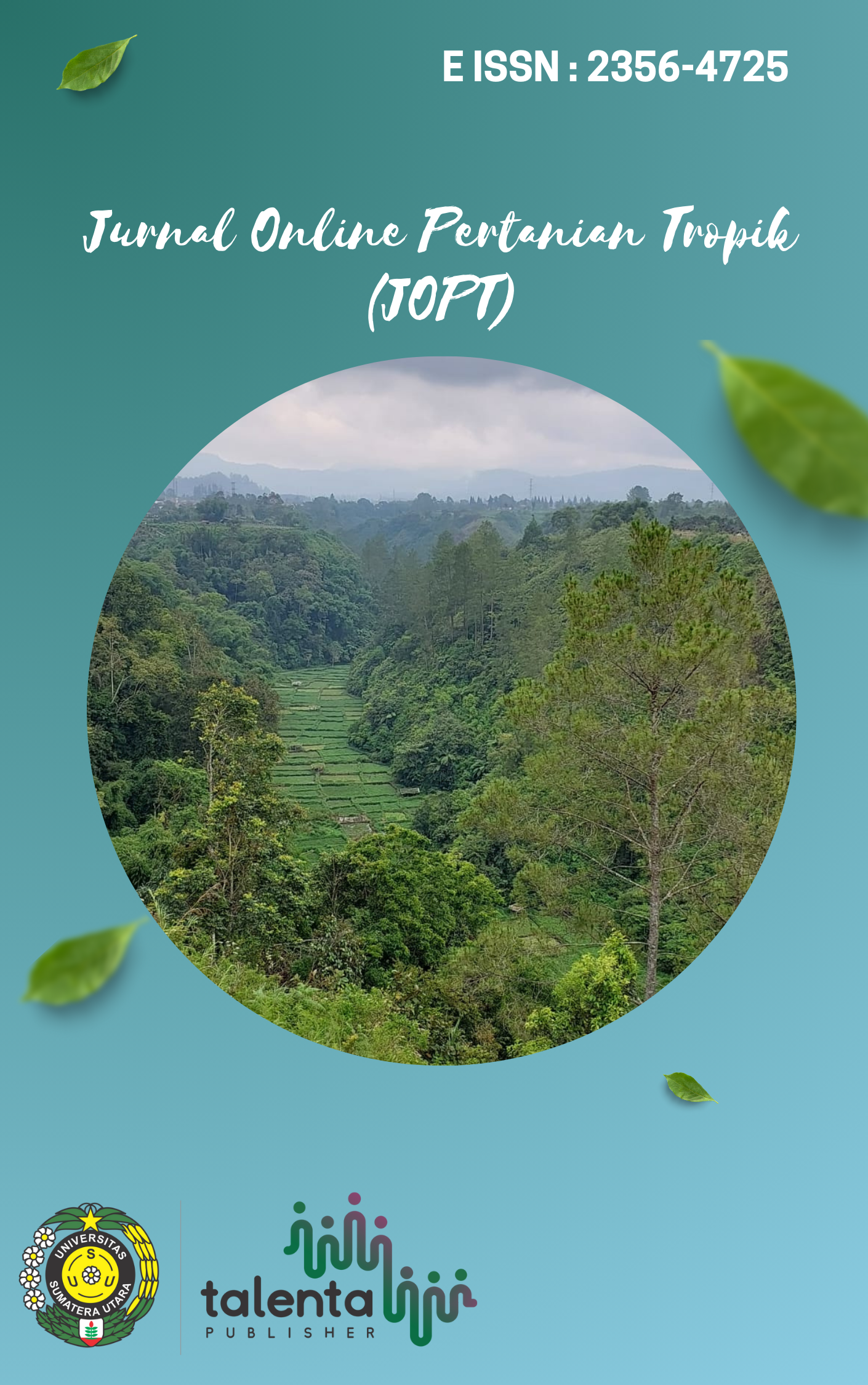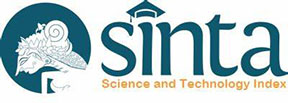Provision of Urea Fertilizer and Organic Fertilizer of Rice Husk Charcoal on the Growth of Oil Palm Seeds
DOI:
https://doi.org/10.32734/jopt.v9i2.9534Keywords:
plant height; leaf area; ultisolAbstract
Good seed growth is a factor in the success of oil palm cultivation due to genetic pre-nursery factors in the field, so that the provision of nutrients in the initial seed growth plays an important role in determining the overall appearance of the seedlings during its growing period. This study aims to determine the effect of oil palm seed growth by applying Uera fertilizer and rice husk charcoal organic fertilizer during the pre-nursery in the field. The experiment was carried out from October 2020 to May 2021 in the experimental garden of the Faculty of Science and Technology, Labuhanbatu University, Rantauprapat at an altitude of 13 meters above sea level. The experimental design in this study was a randomized block design with a factorial pattern that was repeated three times. The first factor is the dose of Uera fertilizer which consists of four levels, namely U0 = 0 kg / ha, U1 = 100 kg / ha, U2 = 200 kg / ha, U3 = 300 kg / ha and the second factor includes the dose of Rice Husk Charcoal Organic Fertilizer (ton / ha) consists of three levels, namely A0 = 0 ton / ha, A1 = 100 ton / ha, and A2 = 200 ton / ha. The results of the experiment showed that there was an interaction effect of uera fertilizer and rice husk charcoal organic fertilizer on plant height (cm),leaf area of ​​oil palm seedlings (cm2), in the number of leaves (leaf) and accretion hump diameter (mm). Treatment of urea fertilizer of 300 kg / ha and organic fertilizer of rice husk charcoal as much as 20 tons / ha produced plant height and leaf area during the pre-nursery
Downloads
References
Ariyanti, M., Natali, G., & Suherman, C. (2017). Respons pertumbuhan bibit kelapa sawit (Elaeis guineensis Jacq.) terhadap pemberian pupuk organik asal pelepah kelapa sawit dan pupuk majemuk NPK. Agrikultura, 28(2).
Effendy, I., Gribaldi, G., & Jalal, B. A. (2019). Aplikasi Sabut Kelapa Dan Pupuk Bokasi Kotoran Ayam Terhadap Pertumbuhan Bibit Sawit Di Pre Nurseri. Jurnal Agrotek Tropika, 7(2), 405-412.
Fadhillah, W., & Harahap, F. S. (2020). Pengaruh Pemberian Solid (Tandan Kosong Kelapa Sawit) Dan Arang Sekam Padi Terhadap Produksi Tanaman Tomat. Jurnal Tanah dan Sumberdaya Lahan, 7(2), 299-304.
Gomez, K. A., & Gomez, A. A. (1995). Prosedur Statistika untuk Penelitian Pertanian (Alih bahasa E. Sjamsuddin & J. S Baharsyah).
Harahap, F. S., Arman, I., Wicaksono, M., Mico, W. T., Rauf, A., & Walida, H. (2019). Pemberian Bahan Organik Pada Lahan Miring Kelapa Sawit Terhadap Analisis Kimia Tanah. Agrica Ekstensia, 13(2), 47-54.
Harahap, F. S., Sitompul, R., Rauf, A., Harahap, D. E., & Walida, H. (2019, May). Land suitability evaluation for oil palm plantations (Elaeisguenensis jacq) on Sitellu Tali Urang Julu, Pakpak Bharat District. In IOP Conference Series: Earth and Environmental Science (Vol. 260, No. 1, p. 012116). IOP Publishing.
Harahap, F. S., Walida, H., Rahmaniah, R., Rauf, A., Hasibuan, R., & Nasution, A. P. (2020). Pengaruh Aplikasi Tandan Kosong Kelapa Sawit dan Arang Sekam Padi terhadap beberapa Sifat Kimia Tanah pada Tomat. Agrotechnology Research Journal, 4(1), 1-5.
Krismawati, A., Arifin, Z., Hermanto, C., & Tafakresnanto, C. (2021, February). Application of biochar to improve maize performance on volcanic and sediment soil based parent materials in dry land. In IOP Conference Series: Earth and Environmental Science (Vol. 648, No. 1, p. 012177). IOP Publishing.
Lubis, A. U. (2008). Kelapa Sawit (Elaeis guineensis Jacq.) di Indonesia Edisi 2. Pusat Penelitian Kelapa Sawit, Medan, 277-301.
Mosharrof, M., Uddin, M., Sulaiman, M. F., Mia, S., Shamsuzzaman, S. M., & Haque, A. N. A. (2021). Combined Application of Biochar and Lime Increases Maize Yield and Accelerates Carbon Loss from an Acidic Soil. Agronomy, 11(7), 1313.
Ogawa, M., & Okimori, Y. (2010). Pioneering works in biochar research, Japan. Soil Research, 48(7), 489-500.
Siallagan, I. (2014). Optimasi dosis pupuk organik dan NPK majemuk pada tanaman kelapa sawit belum menghasilkan. Jurnal Agronomi Indonesia (Indonesian Journal of Agronomy), 42(2). https://doi.org/10.24831/jai.v42i2.8824.
Surya, E., Hanum, H., Hanum, C., & Harahap, F. S. (2019). Pengaruh Pemberian Kompos Bunker Diperkaya Dengan Limbah Cair Pabrik Kelapa Sawit Pada Pertumbuhan Bibit Kelapa Sawit Di Bibitan Utama. Jurnal Tanah dan Sumberdaya Lahan, 6(2), 1281-1289.
Surya, E., Hanum, H., Hanum, C., Rauf, A., Hidayat, B., & Harahap, F. S. (2019). Effects of Composting on Growth and Uptake of Plant Nutrients and Soil Chemical Properties After Composting with Various Comparison of POME. International Journal of Environment, Agriculture and Biotechnology, 5(6).
Walida, H., Harahap, F. S., Hasibuan, M., & Yanti, F. F. (2019). Isolasi dan Identifikasi Bakteri Penghasil IAA dan Pelarut Fosfat dari Rhizosfer Tanaman Kelapa Sawit. BIOLINK (Jurnal Biologi Lingkungan Industri Kesehatan), 6(1), 1-7.
Werner, S., Kätzl, K., Wichern, M., Buerkert, A., Steiner, C., & Marschner, B. (2018). Agronomic benefits of biochar as a soil amendment after its use as waste water filtration medium. Environmental pollution, 233, 561-568.
Downloads
Published
How to Cite
Issue
Section
License
Copyright (c) 2022 Jurnal Pertanian Tropik

This work is licensed under a Creative Commons Attribution-ShareAlike 4.0 International License.






















